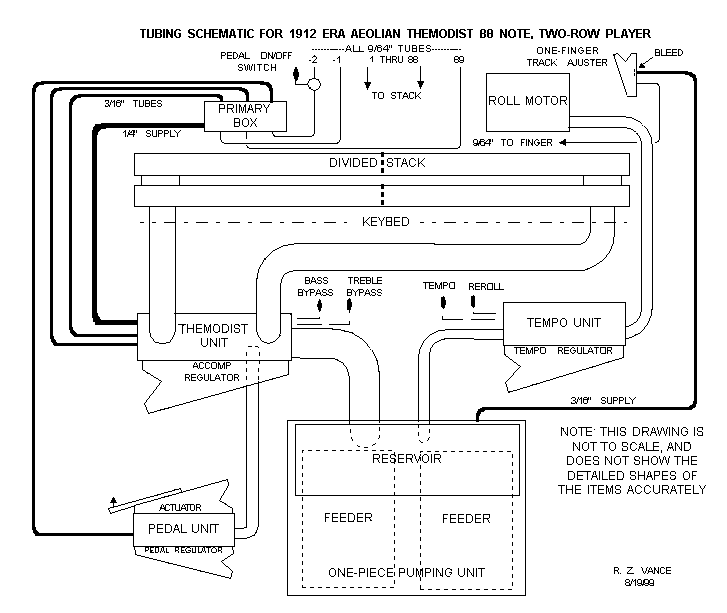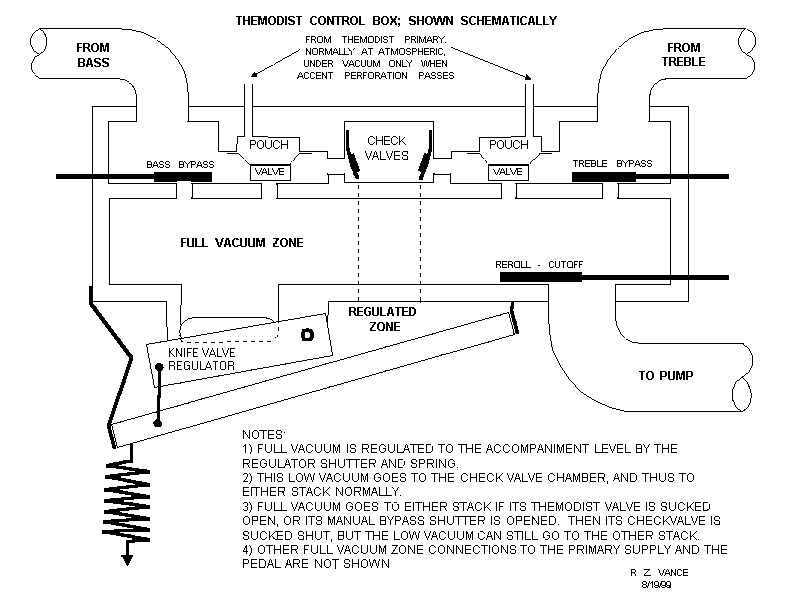| You Are Not Logged In | Login/Get New Account |
|
Please Log In. Accounts are free!
Logged In users are granted additional features including a more current version of the Archives and a simplified process for submitting articles. |
|
MMD
 Tech
Tech
 Themodist
Themodist
 themodistSchematic
themodistSchematic
|
|
by Richard Vance Damon Atchison wrote asking about a tubing connection diagram for the Themodist piano he is working on. He said: > There are three nipples on the pump: one of 1-1/2-inch diameter
There are so many variations over the years that I can not speak with any authority. The player system in my 1912-era Aeolian Pianola Themodist (called Solodant by other companies) has two big hoses from the pump reservoir: one huge hose to the Themodist expression unit, and a smaller hose to the airmotor governor. Another medium size hose goes from the expression unit to the pedal apparatus. > Are there two tubes that supply suction to the stack? Yes. The action stack of the Themodist player is divided into bass and treble halves; each half has its own large (1-inch) supply hose at the end of the stack, and each large hose connects to its own port on the expression unit. Two different suctions are available inside the expression unit, called theme and accompaniment. The louder theme suction is the same as in the main reservoir behind the foot pedals. The harder you pump the pedals, the louder becomes the theme level, as on a regular player piano. The softer accompaniment suction comes from the knife valve regulator on the bottom of the expression unit; the suction level is controlled by the force of the long adjustable spring. The spring can be adjusted as you prefer for 6 to 10 inches accompaniment suction. The main suction supply for the expression unit is via the large 2-inch hose connected to the reservoir. (This hose is 1-1/2-inch diameter in later production.) Accompaniment (regulated) suction is normally applied to both halves of the action stack via one-way check valves. Louder theme level suction, controlled by the Pianolist's pumping, is applied via pouch valves; these are sucked open whenever the pair of theme accent holes ("snake bites") pass over the tracker bar. The operator (the "Pianolist") can also control the application of theme level by moving the hand lever which moves a slide valve to apply theme suction to the stack. A third slide valve inside the expression unit shuts off all suction to the stack (and the pedal system) when the music roll is rewinding. Return springs are often installed to return the bass and treble slide valves to a normal position. Some owners prefer that the springs normally hold the levers in the soft (accompaniment) position. Other owners (like me) spring the levers to be normally in the loud (theme) position so that standard 88-note rolls can be pumped without holding the levers. The air motor governor (tempo regulator) connects to the main reserve with a 1-inch hose, and another 1-inch hose goes from the governor up to the air motor. The governor unit has two slide valves: one is operated by the Play-Rewind hand lever (along with the cutout valve in the expression unit). The other slide valve slowly uncovers a tapered slot which throttles the flow to the airmotor; this is connected to the Tempo lever. The knife valve regulator on the bottom of the governor unit provides a constant suction to the throttle valve. It's about 3 inches water gage suction, which is less than the suction for the softest playing. When the piano is switched to Rewind the slide valve in the governor connects the full pedal reservoir suction directly to the airmotor. Some Themodist actions have two roll tracking fingers (or "ears"), other actions have one finger. In the double-finger system the flapper valves on each side of the music roll are connected to two cutout pouches in the primary box (not shown) which control a pair of linked opposed pneumatics that adjust the spool position. In the single-finger system, one flapper valve on the left edge of the roll connects directly to a single spool-positioning pneumatic, with no cutout. Both methods work well during playing, as long as the leather facing on the edge-sensing finger seals the tube completely. But the later 2-ear design has one advantage: during reroll the primary box is not under vacuum, so the cutout pouches close, isolating the flapper-nozzle lines. Now the double adjusting pneumatic has full vacuum on both sides, and its movable board automatically centers itself, thereby centering the spool for a neater, tear-free rewind. All this is hard to make clear in words, so I have made a couple of rough schematic diagrams, shown below. All the required hose paths are shown functionally, but the actual physical arrangement may be different. Best regards,
22 August 1999 |
|
|
|
|
|
|
|
|
|
CONTACT FORM: Click HERE to write to the editor, or to post a message about Mechanical Musical Instruments to the MMD Unless otherwise noted, all opinions are those of the individual authors and may not represent those of the editors. Compilation copyright 1995-2025 by Jody Kravitz. Please read our Republication Policy before copying information from or creating links to this web site. Click HERE to contact the webmaster regarding problems with the website. |
|
|
||||||
|

